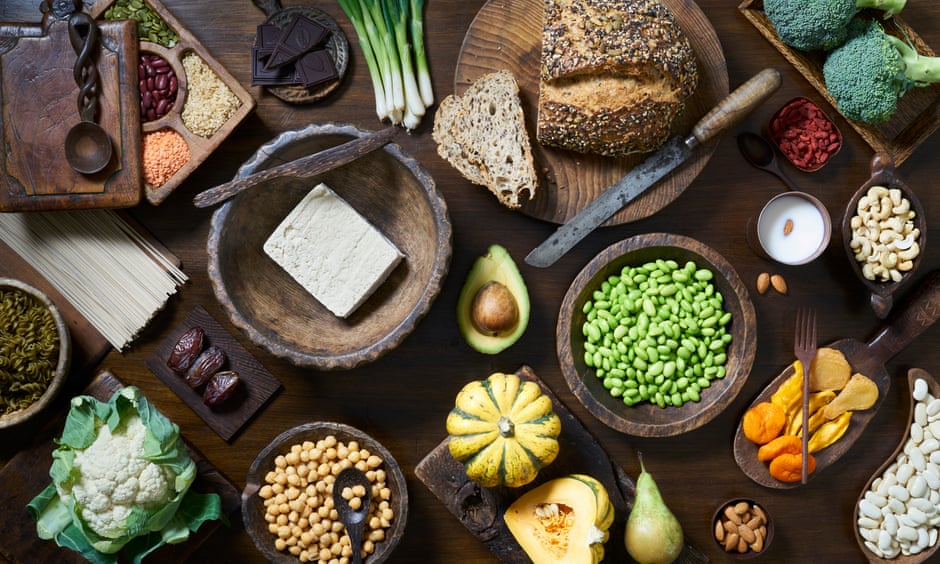
Some time ago, I stumbled over claims made on the internet that spinach (and other vegetables) had more protein than meat. Though I’m positively sure this not to be the case, I continued searching for such claims – you never know. And as we do need to cut back on meat consumption of the mass produced kind, getting more of your protein from vegetables is a good thing, right?
(For all those who know me a little, this is not so much about nutrition and health and all, it’s more about numbers, and how rumours get started 😉
And before we do that, some vocabulary preparation and pre-reading questions
Pre-reading questions
- Can you name all the food items in the image above?
- Do you follow any special dietary principles?
- Are you a vegetarian, vegan, carnivore, omnivore, pescetarian, flexitarian….?
- What do you believe are the best sources of protein?
Pre-reading vocabulary
Match the words with the definitions. Find the words in the text.
| metabolism | legumes | whopping |
| satiating | considerably | cardiovascular |
| staggering | no-brainer | layered |
- the chemical processes that occur within a living organism in order to maintain life
- lentils, peas…
- totally clear, no thinking necessary
- giving a feeling of having had enough to eat
- a lasagna is a typical dish that is cooked like this
- very large
- by a notably large amount or to a notably large extent; greatly
- shocking, astonishing, stunning
- related to heart and blood
Find the following numbers in the text
- 17.1
- 80/20
- 27%
- 68.8
- 50%
- 2.9
Spinach has more protein than beef. Really?
From: Popular Foods With More Protein Than Beef — Eat This Not That
It’s no secret that protein is all the rage these days, and with good reason: it makes you feel full, it helps to build muscle, and studies have even shown that eating more of it can boost your metabolism and ultimately help with weight loss. And while meat may be the first thing you think of when it comes to high-protein food sources, you may be surprised to find out what many other foods have a higher concentration of this macronutrient.
According to the USDA, there are 17.1 grams of protein in a 100-gram serving of 80/20 ground beef with 254 calories. There are 4 calories per gram of protein, which translates to 68.8 calories from protein, or 27% protein per calorie. That may seem like a lot, but it turns out that many legumes, vegetables, and other vegetarian protein sources have even more protein per calorie—which is great news, considering that a 2020 study in Jama Internal Medicine found that eating two servings of red meat a week increases your risk of cardiovascular disease, heart attack, and stroke by 3% to 7%.
(My comment: I would not agree that the study results are so clearly conclusive, as they speak of associations and not causations. However, that’s a different topic. But you can check for yourself Red Meat Consumption and Mortality: Results From 2 Prospective Cohort Studies | Lifestyle Behaviors | JAMA Internal Medicine | JAMA Network)
(…)
100 grams of lentils = 9 grams, 31% protein per calorie
Considering a 100-gram serving of lentils only has 116 calories total, that means it’s made up of a whopping 31% protein, which is considerably more than ground beef. How’s that for impressive? Not only that, but they’re way higher in satiating, gut-friendly fiber, with 7.9 grams per serving. Lentils contain 19.6% RDA of protein for women, and 16.1% RDA for men.
Spinach
100 grams of spinach = 2.9 grams, 50% protein per calorie
It seems like Popeye might have been on to something—because spinach is not only an excellent source of iron, calcium, and vitamins A, C, and K, but it also packs a surprising amount of protein. In fact, because spinach is so low in calories, it boasts a staggering 50% protein. While it’s a no-brainer for salads and side dishes, it also works well in smoothies, on pizzas, in dips, and layered into cheesy baked pasta. (End of quote)
Follow-up questions
- How does the author arrive at her conclusion that vegetables have more protein than meat?
- Are you familiar with the rule of three?
For a lesson session, I would prepare the text, do the pre-reading vocabulary exercise. Look for the numbers in the text, and – after reading – discuss the text parts. Talk about the differences between absolute numbers and percentages.
The following is my comment on the claims and the calculations I performed. They are open for discussion.
After taking a closer look at the calculations, you find some further questions and a link to Gerd Gigerenzer’s TED talk, for additional listening comprehension.
Let’s go through the claims in detail
At this point I won’t question the absolute numbers the author provides, though the amount of protein 100 g of ground beef is supposed to have varies (check e.g. Hopkins Medical).
For our focus here, this doesn’t matter. Let’s just go through her calculations which are the basis for the claim that lentils (and other vegetables) have more protein than meat.
Let’s break down the math:
A Ground beef
- 17 g protein per 100 g ground beef –
- 100 g of ground beef have 254 calories
- 1 g of protein has 4 calories, so we get 17 x 4 = 68 calories of protein for 100 g of ground beef (or 80 if we take 20 for easier calculation)
- 254/68 = 100/26.77 so ca. 27% of the overall calories of 100 g ground beef are from protein
B Lentils
- 100 g lentils have 9 g protein
- 100 g lentils supoosedly 116 calories
- 9 x 4 gives us 36 calories for the protein in 100 g lentils. 36 is ca. 35% of 116.
Thus, the author concludes, lentils have a higher protein content than ground beef.
Let’s do the whole thing with spinach
Spinach has 23 calories per 100 g. In 100 g are 2,86 g protein, which gives us roughly 12 calories of protein if we say 1 g of protein counts 4 calories. That gives us 50% protein for spinach (no idea why it says 39% in the box above.) The author concludes now that spinach has 50% protein per calorie (it should say: calories – per calorie makes no sense to me at all).
What seems true is that spinach’s calories consist of 50% protein calories, whereas ground beef’s calories consist of only 27% protein calories. So the author of the text above would conclude that spinach has more protein than beef.
Are you now as confused as I am?
Further questions
- How much spinach do I have to eat to get the same amount of protein I get from 100 g beef?
- When did we start eating calories instead of food?
Though I do believe we can get sufficient amounts of protein from a plant based diet consuming lots less meat than many do, the claims on this page really baffled me and reminded me of Gerd Gigerenzer’s warnings concerning percentages versus absolute numbers. You find the link below.
Further links
Another page on nutrition facts: soupersage.com
Gigerenzer TED Talk and Why People Believe the Wrong Things is also interesting, a TED Ed talk of five minutes
Also check Mark Hyman’s book The Pegan Diet, especially his suggestion of eating like a regenetarian.
